Press
| A breeder interview with Christer Edling (Salukibladet 2-3/2005) By Katarina PeterssonPage 1Salukibladet congratulates Kennel Shamali and Christer Edling for having received the Hamilton Award and on account of that we will here present the kennel. Kennel Shamali was started by Christer together with his former wife Inger Sjoestroem, but after their divorce Christer alone has represented Shamali. Apart from the Hamilton Award, Christer have also received SKK:s Order of Merit, which can be read about in this magazine. Kennel Shamali is situated about 20 km north of Umea and here Christer and Inger also operated Tjalens dog-boarding house for many years, where they could accommodate up to 30 dogs during the summer months. Naturally with assistance by the two ?kennel girls? that were always around and had that as their ?summer job?. At Shamali, the dogs can always go in and out from the house to the large, fenced-in garden and as a dog buyer one have always been welcome in for a cup of tea. In the summer there was always tea out on the large terrace with the entire saluki pack around you. The Shamali salukis have always lived and lives together in a pack, every single dog has to know his/her place in the pack for them to be able to live together in harmony. Now to my interview that I made a summer evening? | ||
| Congratulations, and I must start with the question what it means to you to have been awarded the Hamilton Award?The Hamilton Award is considered the highest distinction a breeder can get so it feels very nice to receive it. The fact that there are only six saluki breeders who has been awarded it through the years makes me appreciate it even more. How did it come to pass that you became interested in dogs and, in particular, salukis?I had a general interest in animals as a child and, above all, dogs and horses. The breed that I started with was Groenendael, a Belgian shepherd dog. When I met Inger she owned a Labrador, but nourished a dream about owning a saluki. I was not familiar with the breed but its history intrigued me. I have always been very interested in history and the salukis? background fascinated me immediately. Inger drove to Boden 1974 and bought ?Ceiba?, S Ch Khalil?s Ceiba, from Birgitta Strandborg.The next saluki came 1975 as company to Ceiba, ?Daisy?, or Tarana, a red bitch that came from a bloodline with racing dogs. We bought Daisy for racing, and our first two salukis both had racing-licences. We never really got caught up with racing though, so in the end it was exhibitions that became the dominating interest.Racing in that time had started to develop towards price money, something that I was against and there were also other ideas I didn?t share. Naturally, the distances influenced | 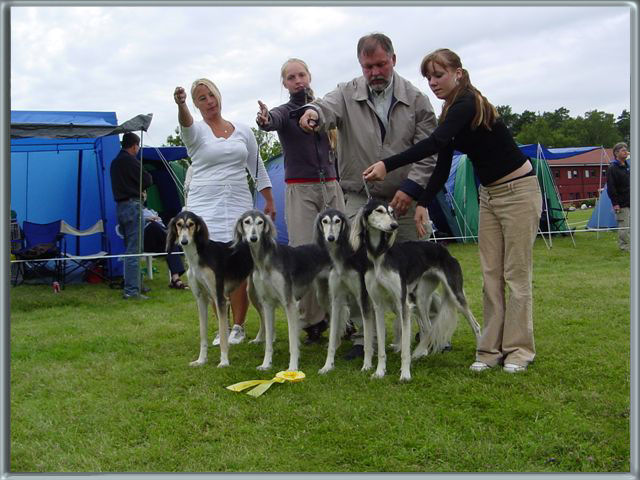 Shamali group from 2005 with Fasqiya, Elishama, Farisa and Gazila (Photo: F Lindgren) | |
| since the nearest racecourse was in Skelleftea, 130 km away. To Alvsbyn we had about 200 km and to Sundsvall even further. Personally, I think it can be hard to be involved in both racing and showing at a high level due to costs and lack of time. Why did you start your breeding? I have always been interested in breeding in general and have had cichlids and later on, sheep. With these interests, it was necessary to study both genetics and ethology (another of my animal-focused hobbies). After starting with salukis my interest in genetics increased. Also, for a few years we had a Connemara mare that we had a foal after, so it was quite natural that breeding started to become more and more interesting. We began looking for a saluki model that we could imagine ourselves to breed. Eventually our eyes were caught by Int & Nord Ch Wenarja?s Wawailah, a very nice and beautiful black grizzled bitch who won quite a bit and was owned by Birgitta Strandborg. We also liked Wawailah?s | sister Ch Wenarja?s Wayin, owned by Ingela Johansson, very much. So we started searching for her/their ?origin?. When we looked at her pedigree we found what we were looking for at Kennel Ben Huri. We were inspired to contact Nils-Lennart Olsson when we saw the advert of him with Udine in his lap. So I phoned Nils-Lennart in order to buy a studdog (we were told later that Ben Huri had never sold any saluki at all for breeding, which makes our conversation even more interesting). We got along real well but he encouraged me to write him a letter. Inger wrote the letter but then we didn?t hear from Nils-Lennart. We waited but in the end I phoned him again and was told that we could buy a puppy. Which proved to be Int & Nord Ch Ben Huri?s Wadj Karmaz, ?Waj?, our foundation male, who came to us 1976. We had written down an ideal (I still have the document we wrote on the subject) that we would like to achieve in our breeding and one of the points in this was to connect the bloodlines that were behind the salukis we loved the most. Ceiba was first mated | |
Page 2
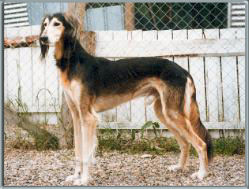 Int & Nord Ch Ben Huri’s Wadj Karmaz (Photo: Katarina Petersson) | You have imported two salukis from England, could you please expand on this?Sedeki Una Uslub, who came to us from Don Wieden in -78, was in a way the first step in our search for correct saluki movements, seen that we wanted the movements that the Sedeki salukis had. Many years later, 1999, I and my daughter Elin travelled to England to visit historical places and experience the myths and tales that abound in England. We had planned for visiting Don and Sedeki but we weren?t aware then that he had puppies at the time. That was the Sedeki L-litter and it woke my interest since, among other things, the mother had many well-known ancestors way back in her pedigree, with many relatives to the salukis that lived in Sweden in the fifties. That the mother had successful coursing dogs in her pedigree was only a plus. Also, that the father was a pure Sedeki was interesting for me. So a male from this litter would add new blood and in the same time renew links to my old Sedeki lines. That was why I decided to buy Sedeki Lale-Zar.To import a dog for breeding purposes demands that you get a lot of information from the breeder you are buying from. Did you feel that you got that information?I had a long discussion with Don about why one buys stud dogs. We talked about the importance of that one believes in the breeder one is buying from and his/her ability to, generation after generation, successfully pick breeding material. This was probably the strongest reason for why I bought ?Lazar?. Yes, I had the information I thought I needed, and since I have followed Sedeki for many years and even visited Don a couple of times, I did not lack information. Don was a very knowledgeable and generous breeder who was more than willing to share his knowledge.There has been desert-breds from Iran to Sweden and to Finland there have been several direct imports from Middle East. What do you think about this?Interesting, but I am not 100% sure that those that have made these imports have chosen the best dogs seen from the point what these dogs can add to us here in Sweden. I am grateful towards those who import them, but I do not think that the standard of the salukis from the ?original countries? is of the quality | |
| with Int & Nord Ch Damasichton (Wawailah?s father) and then twice with a son of his, Ch Wenarja?s Waishal. Our thought with this was to mate a bitch from that litter with Waj. But they never had any puppies and in hindsight that might have been just as well since Ceiba never really corresponded to the type we wanted. So what to do then?In 1977 we travelled to England and visited several breeders: Amena, Windswift, Burydown, Starflight, Knightellington and Sedeki in order to find a bitch that would fit and complement Waj without us being forced to inbreed. At Sedeki we found salukis with the sought-for movements; light, floating and apparently without effort. We ordered a puppy from Don Wieden and ?Sedeki? Una Uslub that came to us a bit later came to be our second brood bitch. It was Nord Ch Zohari Zari-Ba-Yefa, ?Zari? that became our first since she was older than Una, and together with Waj she had our first litter, Shamali?s Q-litter.How did you choose your kennel name? That was simple! We lived in the northern parts of Sweden and were both left-wingers. Shamali means ?north? or ?northern light? and further, ?left-wing parties?. The northern light therefore came to be Shamali?s logo.In what year did you have your first litter?1980How many litters have you had in total?Fifteen litters with a total of 70 puppies have been born at Kennel Shamali.How many champions? Right: Nils-Lennart Olsson of Kennel Ben Huri with young Amir, who, in a straight line descended from the wellknown Ben Huri salukis | Up to today we have had 23 champions. Which make about 33% of all Shamali salukis? champions. Two have become International Champions; Rayyan Hilal and Ummi al Dirw, one a racing champion; SF Ch & Racing Ch Diqhan Rashiq and now last our first lure coursing champion; Fasqiya Sadaqa, she is S Ch as well.How do you find names for the puppies?Through Arabian contacts 🙂On what terms do you sell your puppies?Earlier we had it in the contract that we bought back the puppies if the buyer for some reason couldn?t keep the dog and that we wanted the buyer to contact us if the dog was to be used in breeding, but lately that haven?t been necessary since I have had the opportunity to sell my puppies to ?old? buyers and other well-known saluki people.What dogs have you kept for yourself?We have kept one puppy from almost every litter. We have always chosen bitches that we have thought could fill a special need at every given moment, for instance to improve one or two qualities.Have you sold to other countries?Yes, we have sold puppies to Norway a few times and even to Finland and Italy.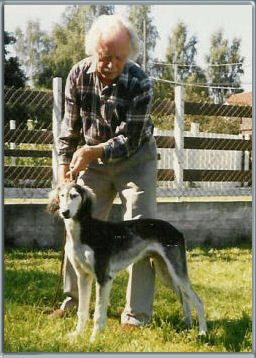 | |
Page 3
| that it was in the 1920?s when larger quantities of salukis were imported by, amongst others, British officers serving in the Arabic world. Please note that they themselves now are importing dogs from Western Europe and USA. Surely this must tell us that they believe us to be able to add quality? If I was to import from the countries of origin I would be very thorough, plan for several years and establish good contacts first. It would take much travelling and much hard work, which would be too expensive for me.Who/which of your litters/dogs do you think correspond best to your breeding goals? Exterior wise? Mentally?Our first two litters, Q (1980) and R (1981) contained several good individuals that laid the foundation for our continued breeding. Especially important for Shamali were Qherun and Rayyan. Qherun ?s bitch lines continue still today which have given many positive qualities such as mental stability, wisdom, alertness and easygoing dogs. Personally I think this bitch line?s quality to have increased over the years, even if it has occurred slowly and unevenly. Rayyan have strengthened good movements and the, | 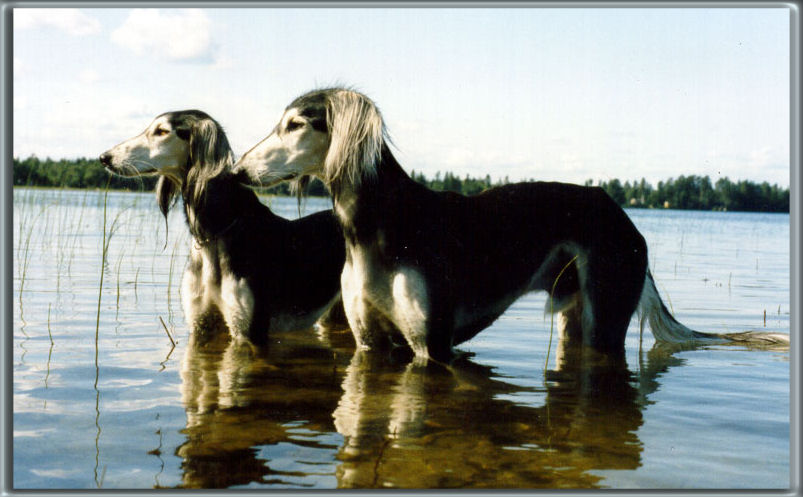 Shamali salukis in the water; The ”twins” Rayyan and Rasila (photo: K Petersson) 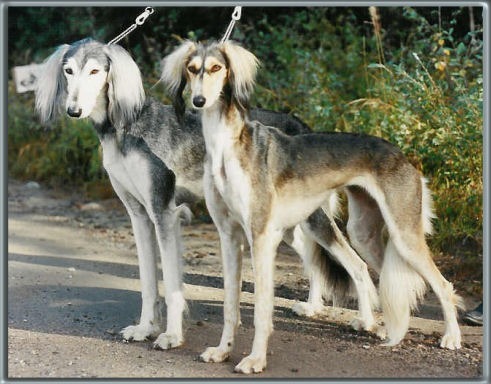 Rayyan and Ch Walda al Alaq, parents to Shamali’s A-litter (photo: K Petersson) | |
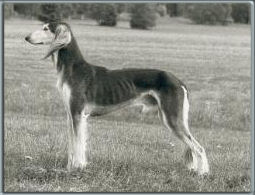 Int & Nord Ch Shamali Rayyan Hilal (photo: K Petersson) for Shamali typical, sound forequarters. Rasila, Yamina, Ummi and Calif were dogs that must be mentioned in this context but unfortunately this line died out.Can you mention any saluki or litter that you have been extra pleased with?I believe that the union of good exteriors and mentality has been highest in the last litters. The litters I ?m thinking of are our A-litter up to now latest the G-litter. 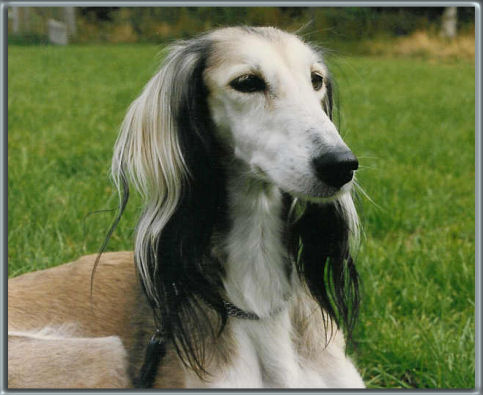 S & SF Ch Shamali Qherun Nizza (photo: L Fris?n) | ||
Page 4
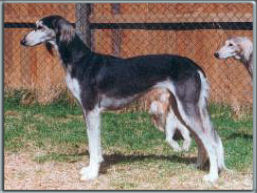 | 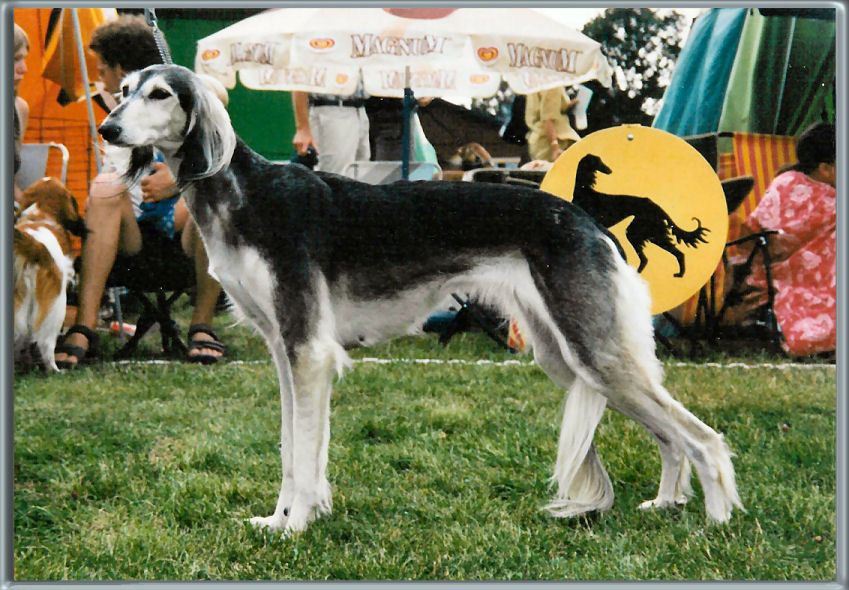 | So there exist no bloodline or country where one with any amount of certainty could claim that its? dogs are entirely spared from the diseases that has emerged in the breed. The dogs that survived WW2 were spread over the entire world. For instance the problems regarding autoimmune diseases are not simple since they are not controlled by a single gene, but of several genes and can lie dormant for several generations and then surface abruptly.Questions regarding diseases that we all must put forward when we are to use dogs in our breeding work are common. One can, after having put these questions forward, only do ones best and use healthy individuals. The situation in Sweden with regard to diseases is pretty good, but the situation must be followed closely all the time. Furthermore, people that import dogs must be warned that it is no solution to import unrelated dogs since there is no way of telling if those dogs carry diseases that are hereditary dominant. You must know who you import from. It has to be persons you can trust and individuals that are healthy.Cryptorchism? Bite error?One of the males in the D-litter was cryptorchid. I have had two dogs (R-litter and F-litter) with overbite in my most out bred litters. The pernial hernia, cryptorchism and bite error have, when I come to think of it, all been in my out bred combinations. Later, when I have returned to line breeding, these have not occurred again. So the lesson here must be that it is not so easy breeding, I definitely do not advocate inbreeding, but there is nothing better than deep knowledge about individuals and lines. I believe one have to come to the conclusion that when we use each others? dogs in breeding we have to be honest so as to get as good basis as possible for our decisions.What has been the driving force for you as a breeder? What has been your greatest satisfaction?As a historian I see it as a unique assignment for the saluki breeders to preserve the saluki as the special eastern hunting dog that it is. Even if the saluki probably have enjoyed to stretch out on couches for several thousand years the breeders charge must be to breed a saluki that can hunt and to see to it that its? eastern ?self? is preserved. My greatest satisfaction is to see sound and healthy salukis born, generation after generation, |
| That is not to say that they were/are the best mentally respective exterior wise, but as a whole I consider them to be the best. My ideal regarding breeding dogs are Qherun, Walda, Aqila and her daughter Elishama. Naturally, there have been other dogs from my breeding that has been successful in the show ring and who has not contributed in the breeding and that is sad, but something a breeder has to accept.Any other now living or deceased saluki you consider a good example?Int & Nord Ch Schiram Ibicus and Int & Nord Ch Wenarja?s Wawailah were early inspirations for us as breeders. I experienced Int Ch Ben Huri?s Adir in the autumn of his life but he must be mentioned. Ben Huri?s had several other fine salukis but I will mention only Fath Ali Cha, Taina (Waj?s mother), Nadidja and Jasmina as examples. I have always been impressed by pictures of Kumasi Rihan, a black and white parti-colored dog that exist behind several Sedeki salukis. He is said to have been an excellent hunting dog and to have brought down a great number of gazelles. Don Wieden had, among others, the beautiful Ch Sedeki Falu when I was in England the first time and it is hard to refrain from mentioning her. I will also mention Int & Nord Ch Sedeki Hamah that I got to know as a young dog and who has had such an impact on Swedish saluki breeding. Last, and without mentioning any particular individuals, I must establish that Birgitta Nordqvists fantastic red ochre-colored grizzles always impressed me with their soundness, uniformity and their good movements.Are there any particular bloodlines that you wanted to have in your breeding?The old Swedish lines with Ben Huri and Ibinore have been our starting point. Dogs from these breeders or related individuals have been pivotal as soon as I have had the opportunity to utilize them.Can you elaborate a bit on what you have thought about in your breeding plans? | All our litters have been carefully planned and we have kept to the ?track? even if we have been forced to make deviations with some individual/s, but more often than not we have used some sibling, an offspring or other relative when we for some reason has been forced to make adjustments. We planned, and I still plan, 3-4 litters ahead. I have always had the ambition that every generation shall signify some progress towards our breeding goals. In the same time one must always heed that every new generation may add new problems or qualities that needs to be worked upon in coming generations. This is the enchantment with breeding!What have you used in your breeding; out breeding, line breeding or inbreeding?Out breeding and line breeding have been combined consistently. We have tried to obtain ?type breeding?, i.e. where the individuals have been so much alike as possible even if they have been more or less nonrelated. ?Domestic import? is something we have used from time to time since it is important to add new blood. With ?domestic import? I mean that you use individuals that do not belong to the, for the moment, dominating breeding stock. It is extremely important that we have a broad breeding base to work with and direct imports are not always the solution for this problem. Many times when we have out bred there have been similar backgrounds further back in the pedigree.Have you run across any problems, for instance illnesses, during your years as a breeder? Any problems that has occurred with your imports?I have not come across any specific problems with my imports. Two of the dogs in the first litter had perinal hernia, but that has not occurred since. The parents to these litters were, interestingly enough, not that closely related. Every breeder today has to keep an eye on his/her breeding with regard to diseases. I have studied this very thoroughly and most bloodlines in the western world are descended from British salukis that survived WW2. |
Page 5
| and to live with these wonderful salukis. Of course, the social intercourse with dog buyers has been a great joy.What have been your biggest successes in the ring?I was really happy when Ummi won the group (BIG) in Alvsbyn 1989, which led to a front page picture in ?Hundsport? (SKK’s monthly magazine that goes out to every member in Sweden). Ummi was an incredibly good bitch, well constructed and with fantastic movements, so it was with great pleasure I received that price. It was also a very emotional experience to be standing ringside watching Rayyan win BOB and becoming BIG-4 eleven years old and then winning BIS-veteran at Boden?s International Show 1992. Last I also want to mention Elishama?s three best-bitch placements the three years in a row that she was showed at the Tammsvik Show, -00, -02 and -03. Summer -01 she remained at home as mother to the F-litter.How important are successes in the ring?It?s fun and expensive! From a breeding point of view I do not consider them important at all. I do however feel that salukis should be showed and that certain merits should be demanded. Nowadays I do not exhibit my dogs so much so I?m not really all that familiar with the competence of today?s judges. But I?m convinced that they do not have the same ?base? in the hunting- and horse world as earlier generations of judges. Therefore, they do not have the same fundamental competence when it comes to construction and movements that some of the earlier judges had. Due to this, they might sometimes lack the understanding that is necessary in order to grasp the meaning of construction and movements in a breed such as the saluki with it?s? origin as a hunting dog.What responsibility do you feel breeders and judges have for the future of the breed?The breeders have absolute responsibility and it is up to the breeders to decide what influence show ring successes are to have in the breeding. The breeders must be able to sift through the judges decisions when choosing their breeding material. And judges must realize that there are breeders who do not ignore the importance of such successes, and because of that they have a responsibility for the breeds? future, as well. | 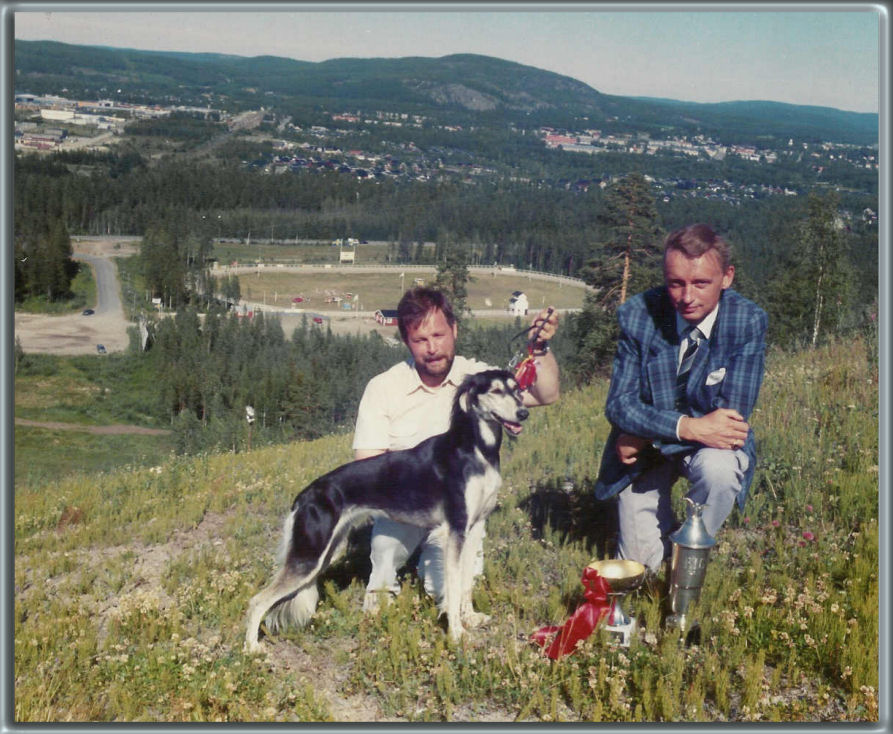 Christer with Int & Nord Ch Shamali Ummi al Dirw, BIS in Alvsbyn for ConnyBystroem (Photo: T Widholm) | |
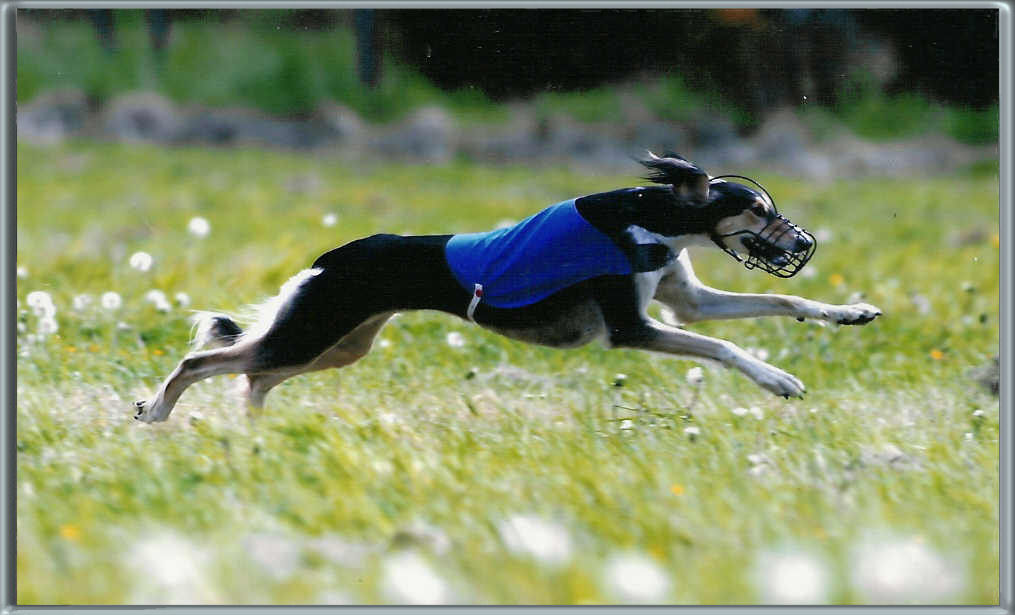 Shamali’s first lure coursing champion: S Ch SL Ch Shamali Fasqiya Sadaqa (Photo: C Dirksen) | ||
| Have any salukis from your breeding competed in racing and/or lure-coursing?We did the racing during a few years in the beginning and now that lure-coursing has become an official competition form where many dogs from our breeding has been in from the start. Now last Fasqiya that has been really good; Swedish LC Ch this year and last year she won so much that she became the top-winning lure-coursing saluki 2004.For you, what is important in a saluki?It is important to understand the type of dog it is, a fast hunting dog with the typical eastern mentality that do not include an ingratiating behavior, it leads to a truly unique breed. When a saluki of today is at its best it holds a low but friendly profile towards strangers, i.e. they are reserved in a dignified and friendly way. The saluki should have a sound construction with, above all, well constructed forequarters with a shoulder set well back and a well angulated upper arm. A powerful hindquarter is to be held together with the forequarter by a deep ribcage and a strong loin. Finally, it is extremely important to preserve the breeds? unique movements. Do you feel that temperament | carries too little weight when selecting breeding material in our breed?Difficult to answer, mentality is one of many factors that has to be taken into account when you choose your breeding material. In practice, it looks as if we today have a reasonable mental status on our salukis. Remember that the saluki is not, and never can be, a ?retriever breed?.Any specific breed quality you consider important and that is fading?I am quite convinced that, just as the salukis? special ?floating? in its? movements always have been in danger of disappearing, it stands an even greater rise of disappearing now. I believe this to be due to insufficient roots in the horse world, which gives that there is a lack of practical knowledge (gained by riding) concerning the importance of the ”floating” moment in the movements. I have started on a new article regarding movements, but as always I have much to do so I?m not sure it will ever be finished. Then there are other details that all breeders have to struggle with, for instance the typical saluki paw and the pasterns. To be a breeder is a struggle against time. Every generation of breeders must sometime return to his/her sources and fight to keep the prevailing generations? whims at bay. | |
Page 6
Every breeder generation must strive to improve the average of his/her breeding in order to give his/her contribution to this struggle. It is now (2004) 31 years since you started with saluki. Compare today?s saluki with those you came into contact with when you started. Are there any differences?My impression of the old Swedish salukis from the 50?s and 60?s is that they often had very good forequarters.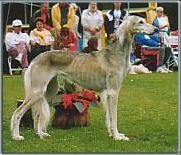 Ch Shamali Yamina a Mahir winning BIGSince I know that when it comes to ridden horses it is the forequarters that breaks first, as goes with hunting dogs as well, it worried me when I in the 70?s saw entire bloodlines with weak forequarters. I remember once when two salukis jumped a big ditch and the dog with good forequarters made an elegant jump and continued galloping while the dog with bad forequarters jumped and broke a leg. This thing with forequarters has rectified itself somewhat in our breed. What worries me nowadays is that as a new breeder you may only put abstract aesthetical aspects on your choice of breeding material and the danger of this is biggest if one do not have a background in the hunting- or horse world or if one lacks the support from an older breeder that keeps the tradition about breeding ?the hunting dog model?alive.There are two areas from where one can get inspiration as a saluki breeder. One is the equestrian world and the other is the hunting world. | The finesse with being active in the equestrian world is that you learn the importance of sound forequarters and good movements. By riding and feeling how good it feels on a horse with good movements compared to riding horses with bad movements you get an increased understanding for the importance of the construction. The other area is, then, the hunting world. There, one learns the importance of construction, durability and stamina in a good hunting dog. Knowledge about hunting shows these undisputable facts.There are many qualities (speed, endurance etc) that cannot be evaluated in the ring and which are important for how functional the saluki is as a hunting dog, according to people with many years of coursing experience. What is your opinion, how should we keep the saluki functional?There are no shortcuts! It is the historical knowledge and the experience we can get from hunting with similar breeds and from the equestrian world that we have at our disposal. That is what we must take in and when we compromise with these experiences and this knowledge we will get into trouble. Activities such as lure-coursing have | values but must be put into context since we have to understand that they cannot fully correspond to the hunting situations that salukis were in when hunting in their native countries.Are there any other breeders that you would like to mention in particular? Who? Why?Then I would like to mention three: Nils-Lennart Olsson (Ben Huri), Don Wieden (Sedeki) and Birgitta Nordqvist (Zohari). It is these three whose dogs have been most important for Shamali and in whose breeding I have seen many of the most beautiful salukis I have ever seen.Do you have any cooperation with any other saluki breeder?There are a few I have always exchanged thoughts with and still do. I have never had any direct cooperation with any one breeder but I?m always open for new possibilities to cooperation.Any particular advice you would like to give newcomers in the breed?My advice is to read up on the salukis? history and try to understand that this is a hunting dog that do not exist in Scandinavia and that their way of being and reacting stands apart. |
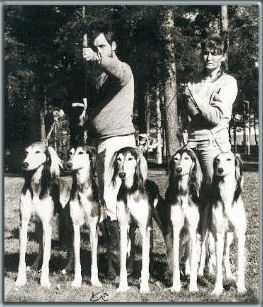 Christer & Inger with Qadir, Rihla, Rayyan, Rasila & Qherun, SKK Umea -85 (Photo: K Petersson) | ||
Page 7
| One has to be careful when letting them loose and they cannot be treated as commandoes. A properly treated saluki will be a very good friend and will give a lot of joy with his/her special way of being. It is easily forgotten then how hard it can be in the beginning to get this eastern dog to be well functioning in everyday life.What do you think is important for those that are to breed salukis?You should think about the responsibility that it brings. It is not the same responsibility as when breeding, say Cavalier King Charles or Labradors. Most breeds do not have the cultural dignity that the saluki have with its? several thousand long history. One ought to put the question to ones? self why you want to breed. Why? What?s the motive? Which qualities you want to preserve? What type of saluki do you want to pass on through your breeding? Saluki is a breed where many types are permitted. Think about what my contribution to the breed will be? Because I most definitely do not think one should breed salukis only to have puppies and because puppies are pretty. | Saluki breeding is much too serious to be based upon so unserious motives. If so, I think it is better to breed some other dog without the cultural dignity the saluki has. It is and has been an important mission for every saluki breeder in all times, and not the least for present day breeders, to act for preservation of the different types. Which do not mean that one has to be totally absorbed only in ones? own type, one can always try to help other breeders by lending a stud dog etc, this is a perfect area in which breeders can cooperate. Thoughts like these make me think with some sadness about breeders like Ben Huri or Zohari with the thought-through breeding that were pursued there and then. | What plans do you have for the future?I have a plan, but I realize that I?m at the end of my breeding work. If there is to be a continuation depends on a number of factors. At best, I have plans for another 4-5 litters.What has your life with salukis meant to you?Very much, and periodically it has dominated my life. I love my dogs and I feel it is a privilege to be part of the several thousand year long project that it is to preserve the saluki breed. A project where any one breeder is no more than just a tiny cog, but still not without value.Thank You, Christer! |
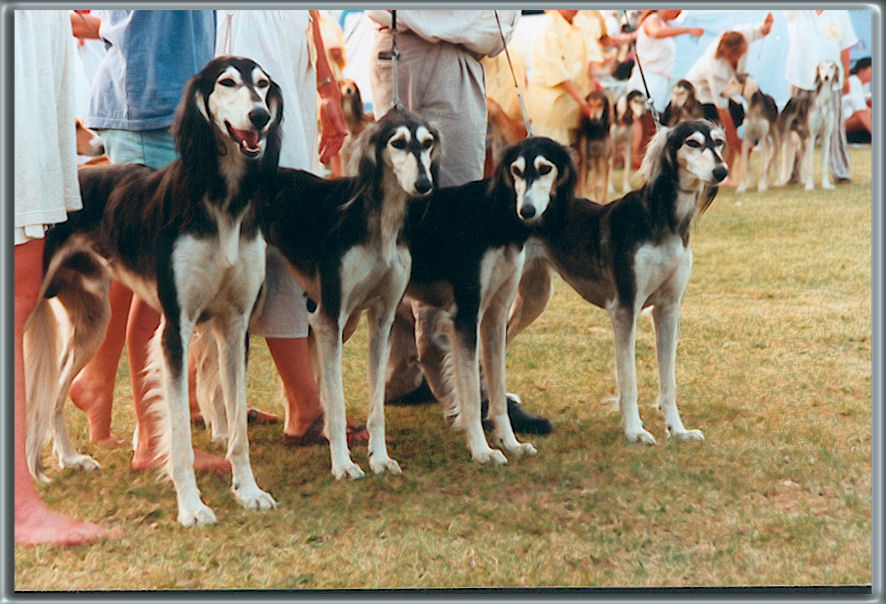 A Shamali breed group at Skokloster. From Left: Calif, Aqila, Duwliya & Bikri. | ||
Translated by Benny Wallin